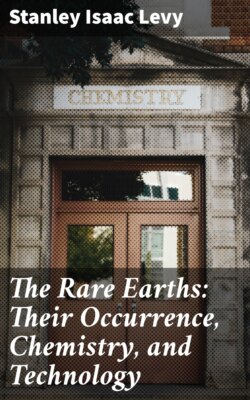Читать книгу The Rare Earths: Their Occurrence, Chemistry, and Technology - Stanley Isaac Levy - Страница 165
На сайте Литреса книга снята с продажи.
(b) Silicates of Thorium and Zirconium Thorite.
Оглавление—Thorite and its variety Orangite are somewhat altered forms of a pure silicate of thorium, ThSiO₄, containing also small quantities of water, usually uranium, and often rare earths, with iron, lead, calcium, and aluminium. Orangite differs from thorite in its beautiful orange colour and greater specific gravity. Both varieties are radio-active.
When unaltered, the crystals are tetragonal and uniaxial, the pure mineral ThSiO₄ being isomorphous with zircon, ZrSiO₄ (q.v.). By alteration they become isotropic.
Crystals are tetragonal, holosymmetric; c = 0·6402; p ∧ p´ = 56° 40´.
Common forms are the prism m {110} with the pyramids p {111} and z {311}.
Hardness 41⁄2-5; sp. gr. 4·4 to 4·8 for thorite, 5·2 to 5·4 for orangite.
Thorite contains from 1·4 to 3·1 per cent. of rare earths. According to Nilson and Blomstrand, the uranium is present as uranium dioxide, UO₂ replacing thoria, ThO₂, but Dunstan and Blake state that the two oxides are isomorphous (see under Thorianite, p. 74), and so they might be expected to be vicarious. Thorite was discovered by Esmark in 1828, and first analysed by Berzelius,[48] who announced the discovery of a new earth in it in 1829. The name Thorite is from Thor, the god of Scandinavian mythology.
[48] Pogg. Ann., 1829, 16, 385.
Thorite is a member of a peculiarly interesting series of isomorphous minerals, which includes Cassiterite (SnO₂), Rutile (TiO₂), Zircon (ZrSiO₄), and most probably the allied silicate Naegite, and the rare earth phosphate Xenotime (q.v.), which are very similar in forms and angles. The oxide TiO₂ is itself trimorphous, being known in the three crystallographically different forms, Rutile, Anatase, and Brookite (q.v.). On account of the isomorphism of cassiterite and rutile with the two silicates, it has been suggested that the oxide formulæ be doubled and written Sn(SnO₄) and Ti(TiO₄) respectively,[49] to show the analogy with Th(SiO₄) and Zr(SiO₄). Consideration of the molecular volumes (obtained by dividing molecular weight by specific gravity, i.e. multiplying by specific volume) lends a certain amount of support to this view. It has often been observed that isomorphous compounds, and many compounds which occur in parallel growth to one another, have nearly equal molecular volumes; there are, however, many exceptions. Taking molecular volumes for the series under consideration, we have, using approximate numbers only—
| Mol. Wt. | Sp. Gr. | Mol. Vol. | ||
|---|---|---|---|---|
| Cassiterite, SnO₂ | 151 | 6·9 | 22 | |
| Rutile, TiO₂ | 80 | 4·2 | 19 | |
| Zircon, ZrSiO₄ | 182 | 4·7 | 39 | |
| Thorite, ThSiO₄ | 325 | 5·4 | (Orangite) | 60 |
| Xenotime, XPO₄ | 184 | 4·5 | 41 |
[49] This isomorphous series has recently been extended by Zambonini, and also by Schaller, by the inclusion of minerals containing Columbium and Tantalum; see under Ilmenorutile and Strüverite, end of Ch. IV., p. 71.
It will be seen that if the numbers for cassiterite and rutile be doubled, four out of the five show very fair approximation to the constant value 40. The number 60 for thorite is quite irreconcilable with the values obtained from the other members; of course pure silicate of thorium, ThSiO₄, is not known as a mineral, but it is most unlikely that the relatively small amount of impurity in the densest specimens of orangite should have depressed the specific gravity by over two units, as would be required if the molecular volume of thorite were to show even the most approximate semblance of agreement with the others. It cannot be too often remarked, however, that very little indeed is known of the molecular formulas of minerals, and that very little reliance can be placed on such figures as the above. On the contrary, it is hardly conceivable that amphoteric oxides like those of tin and titanium, occurring in the form of heavy crystalline minerals, should have molecular formulæ only double the empirical formulæ. Where agreements of the kind do occur, they must be taken as indicating approximately equal degrees of molecular complexity in the minerals concerned, rather than as affording any real insight into the molecular condition.
